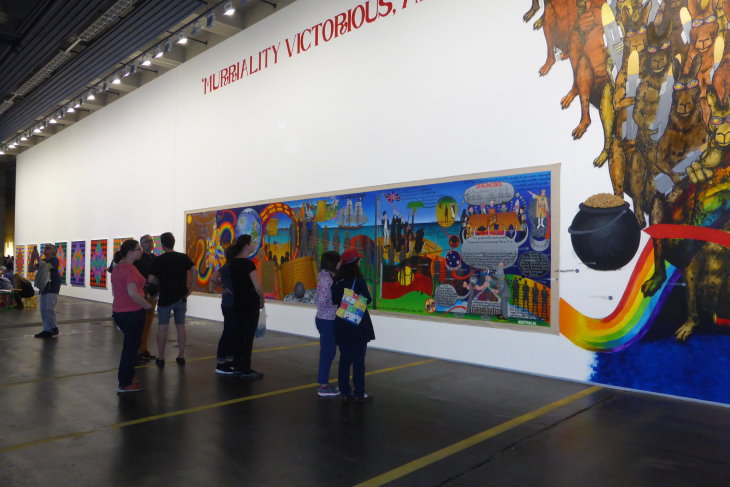Introduction
 Art critics wrote many reviews about the messy nature of this year's documenta 14. But say what you may, it surely illustrated the planetary scope of contemporary art through the huge span of works exposed in Athens and Kassel and through the disparate commentary of an equal number of artists, curators, historians presenting them in the Daybook. Spread out over some 20 venues in Kassel alone and almost as many in Athens, the exhibition offered many highlights that did not fail to speak to the visitor. The sheer diversity made sure that everybody could attune to some of the works shown. And the record numbers of visitors bore that out. A large number of performances by women artists added reflections on gender equality and the human condition in different parts of the world. Marta Minujin's "The Parthenon of Books" to the right was half filled by donated books prohibited at one point in time or other in different countries around the globe.
Art critics wrote many reviews about the messy nature of this year's documenta 14. But say what you may, it surely illustrated the planetary scope of contemporary art through the huge span of works exposed in Athens and Kassel and through the disparate commentary of an equal number of artists, curators, historians presenting them in the Daybook. Spread out over some 20 venues in Kassel alone and almost as many in Athens, the exhibition offered many highlights that did not fail to speak to the visitor. The sheer diversity made sure that everybody could attune to some of the works shown. And the record numbers of visitors bore that out. A large number of performances by women artists added reflections on gender equality and the human condition in different parts of the world. Marta Minujin's "The Parthenon of Books" to the right was half filled by donated books prohibited at one point in time or other in different countries around the globe.
The show started in Athens on 8 April and closed in Kassel on 17 September 2017.
Here we only show pieces from four artists from three continents, all somehow linked to a core concern of the show, namely that oppression's ghastly face has brought untold suffering on people around the globe, but that strangers can meet and that as humans we can cooperate and learn from one another across the continents and the seas. We share the artworks together with remarks from the curators gleaned from the documenta 14 Daybook. Enjoy our small selection and explore more on the many artsy websites that let documenta 14 live on if you missed it. All pictures by CE Nauen.
El Hadji Sy from Senegal
Disso – Concertation (2016) - Installation with Paintings and Sound
Flashback to a meeting with El Hadji Sy in his studio in Dakar in the early 1990s: I have trouble photographing his pictures individually. Sy directs my gaze so that in each shot an excess drawing, another work emerges - explicitly positioned over the larger painting that I'm after. In addition, the person of the artist himself - a human figure that moves, breaking the spatial axis of the various static elements. The result is blind spots from which incongruent signals flash - signals that, in turn, oscillate between different art histories.
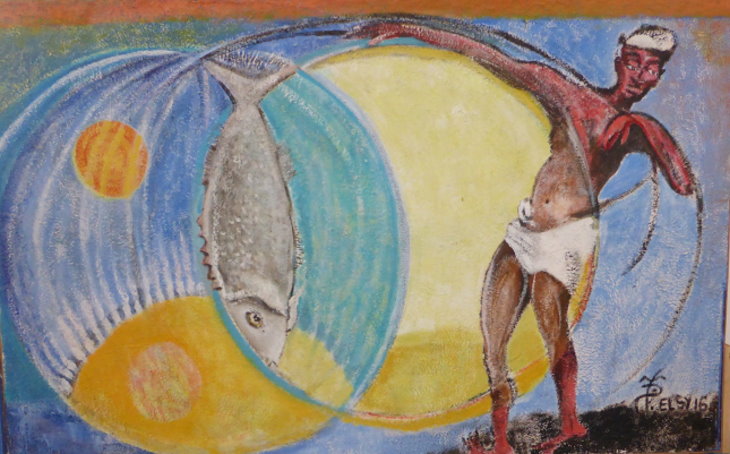 As a painter, curator and activist who has always remained true to his native Senegal, Sy, born in Dakar in 1954, stands for a position that is free of any isolationist genealogy. His first solo exhibition abroad took place in Chicago in 1981 in Paul Wagoner's unconventional art spaces. At that time, Sys's work was in confrontation with the normative genre of painting proclaimed by Senghor's cultural regime of the 1970s. For ten years he insisted on painting with his feet. At the same time he founded several art collectives (Laboratoire Agit'Art, Tenq and Huit Facettes Interaction) and occupied buildings built by foreign powers - French colonialists and Chinese Communists.
As a painter, curator and activist who has always remained true to his native Senegal, Sy, born in Dakar in 1954, stands for a position that is free of any isolationist genealogy. His first solo exhibition abroad took place in Chicago in 1981 in Paul Wagoner's unconventional art spaces. At that time, Sys's work was in confrontation with the normative genre of painting proclaimed by Senghor's cultural regime of the 1970s. For ten years he insisted on painting with his feet. At the same time he founded several art collectives (Laboratoire Agit'Art, Tenq and Huit Facettes Interaction) and occupied buildings built by foreign powers - French colonialists and Chinese Communists.
As early as 1988, Sy published the first art-critical anthology on contemporary art in Senegal and put together a collection of new works by his male and female artist colleagues for a German museum. His recent retrospective at the same institution (El Hadji Sy: Painting, Performance, Politics, Weltkulturen Museum, Frankfurt am Main, 2015) not only demonstrated the breadth of his practice, but also his perception of the challenges associated with ethnographic collections. For example, the artist refers to these discrete artifacts as "pitfalls of conscience" and speaks of the horror emanating from these objects - objects that challenge the ethical stance of the viewer and require a semantic upgrade that is capable of breaking the boundaries of anthropological discourse.
Sys's unruly stance still stands for an aesthetic struggle at the agonistic crossroads between community involvement and solitary self-denial. "How do we socialize the production of the mind?" asks the artist, whose current conceptual work in Dakar combines large-format choreographic paintings with radio broadcasts that he heard as a boy. These programs were addressed to farmers and fishermen and dealt with urgent questions of development policy in a post-colonial Senegal. Sy extracts the radio jingle, which - like the fleeting trace of a fragrance - recalls a specific moment. This gestural renewal links the iconic with the acoustic, the synesthetic with the political, awakens superimposed memories and condenses the performative knowledge of the past with unresolved problems of the present lifeworld.
- Clémentine Deliss
Posted in Public Exhibition
Excerpt from the documenta 14: Daybook
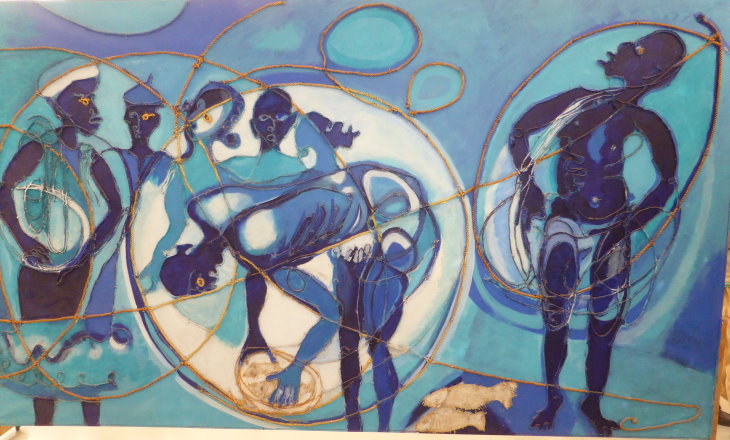
"The Fishers" (Les pêcheurs), acrylic on canvass with cords and other mixed media, 2.1 x 3.5 m.
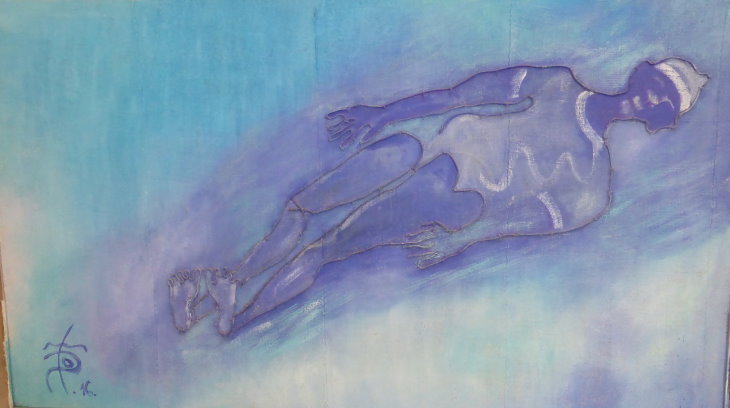
El Hadji Sy - The Drowned from the cycle Disso-Concertation, acrylic on jute
The late Beau Dick from Canada
with masks from the cycle of the "Untersea Kingdom”
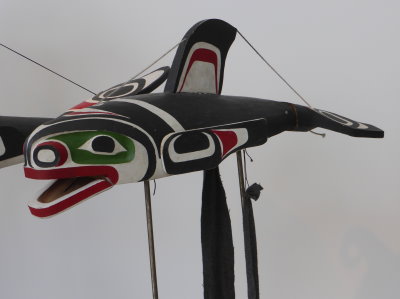 Beau Dick’s name in the Kwakw’ala language means “big, great whale.” His carvings often feature Dzunuk’wa, the “wild woman of the woods,” and her counterpart, Bakwas, “wild man of the woods.” These supernatural figures loom large in Kwakwaka’wakw cosmology and also in Dick’s practice. Bakwas is a stealer of souls. He lures his victims with poisonous food—toads, snakes, lizards, and maggots. Those who consume his offerings become Bakwas, forever trapped in the house of spirits. Dzunuk’wa is a cannibal. She lumbers through the woods, plucking out disobedient children and putting them in her cedar basket for later eating. Her giant face is black as though charred from a fire, and her red lips are always pursed as though about to cry out, “HUU! HUU!”
Beau Dick’s name in the Kwakw’ala language means “big, great whale.” His carvings often feature Dzunuk’wa, the “wild woman of the woods,” and her counterpart, Bakwas, “wild man of the woods.” These supernatural figures loom large in Kwakwaka’wakw cosmology and also in Dick’s practice. Bakwas is a stealer of souls. He lures his victims with poisonous food—toads, snakes, lizards, and maggots. Those who consume his offerings become Bakwas, forever trapped in the house of spirits. Dzunuk’wa is a cannibal. She lumbers through the woods, plucking out disobedient children and putting them in her cedar basket for later eating. Her giant face is black as though charred from a fire, and her red lips are always pursed as though about to cry out, “HUU! HUU!”
In Dick’s hands, masks are not simply masks, they are animate beings that have important roles outside the confines of contemporary art. He is continually short-circuiting their status as a commodity. In 2012, he removed the forty Atlakim (Forest) masks from the walls of his gallery and brought them back to his community in Alert Bay, where they were danced for a final time and then ceremonially burned. There is rebirth within this destruction, as now there is a responsibility to carve a new set of masks, which in turn keeps them alive.
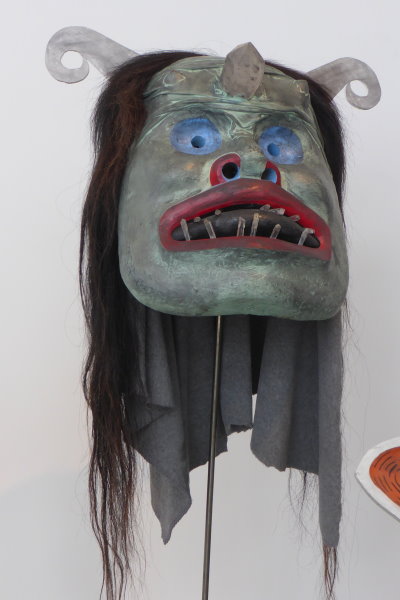 |
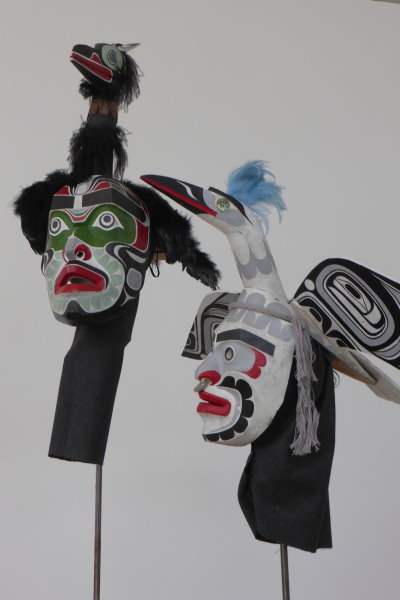 |
Beau Dick - masks from the cycle "Undersea Kingdom"
A hereditary chief, Dick (born in 1955) is highly active in his community. As soon as the ferry docks, his hand is visible, from carved totem poles at the top of the hill to memorial poles near the shore of the bay. Lately, he has also been galvanizing those outside his village. In February 2013, inspired by the activist movement Idle No More and spurred on by his daughters Linnea and Geraldine, they walked south from Quatsino to Victoria, British Columbia, where in the presence of some three thousand people they broke a copper named Nunmgala on the steps of the BC Legislative Assembly. In 2014, he gathered even more supporters and broke copper on the steps of Parliament Hill in Ottawa. Dick, the maker of monsters, is exposing some too. The coppers broken on the steps of two houses of power are a call against colonialism and capitalism: “In breaking this copper we confront the tyranny and oppression of a government who has forsaken human rights and turned its back on nature in the interests of the almighty dollar, and we act in accordance with our laws.”
—Candice Hopkins
Posted in Public Exhibition
Excerpted from the documenta 14: Daybook
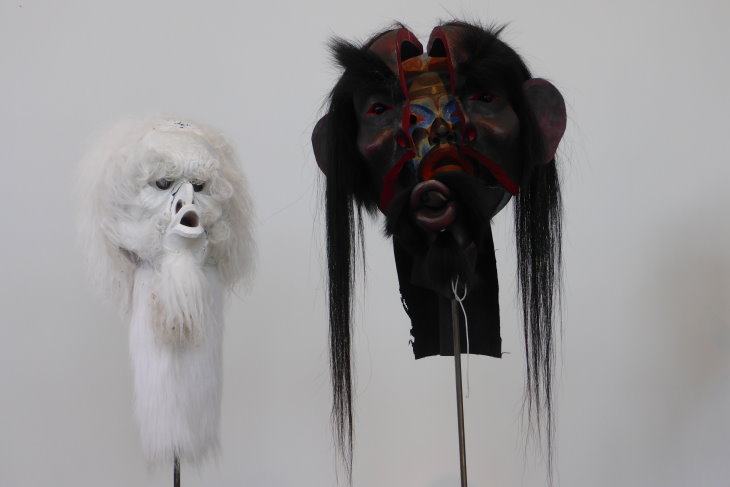
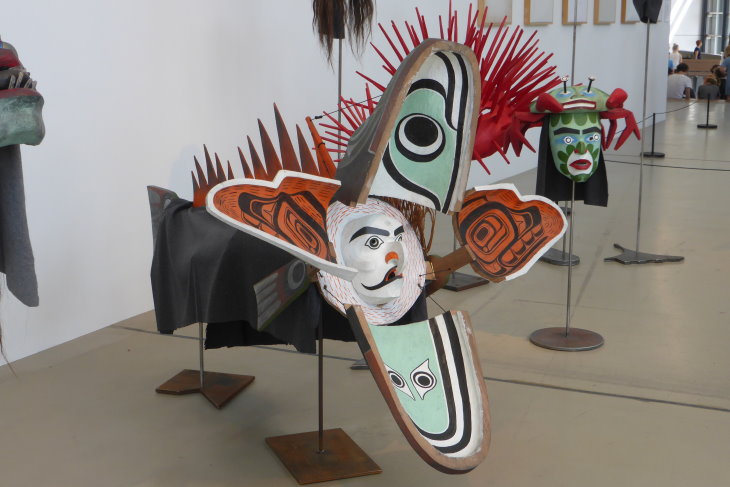
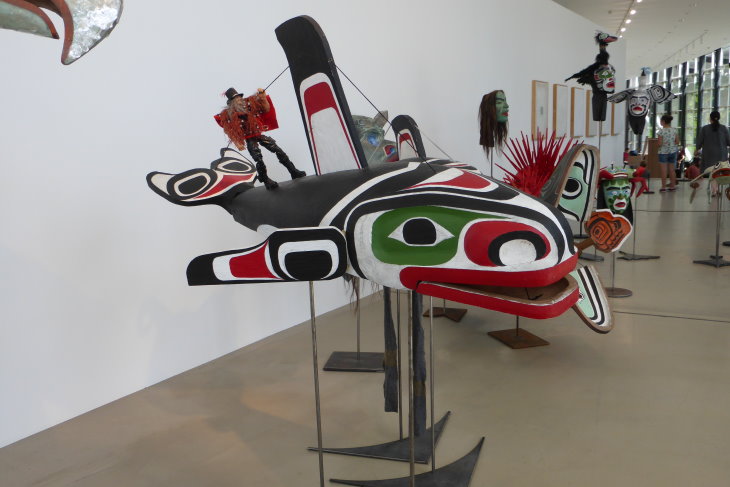
Beau Dick - more masks from the cycle "Undersea Kingdom"
Beau Dick passed away without seeing the end of documenta 14 where his masks made deep impressions on the many visitors. We keep fond memories of Beau Dick, not least since he welcomed us in 2014 on the unceeded territories of the First Nations in British Columbia for an International Roundtable at the Peter Wall Institute for Advanced Studies at the University of British Columbia, Vancouver. He generously shared with us insights from his political struggle against oppression and for reconciliation and showed us a selection of his impressive art works touching us profoundly with his humanity.
Guillermo Galindo from Mexico
with scraps of plastic and wooden boats lost at sea in the attempt to reach Europe, now forming a sound instrument
In 2012 Guillermo Galindo began working on Border Cantos, a collaborative project with Richard Misrach that has taken him along the lengths of the border that divides Mexico and the United States, the most militarized region in North America. It was there that he started collecting discarded things. First small things: a weathered plastic comb, used water bottles, brittle animal bones. And then larger items: twisted pieces of corrugated metal roofing, chains, tires, and finally, a whole series of clothed effigies of migrants that had been strung up in an empty tunnel, left to rot from the heat of the desert sun.
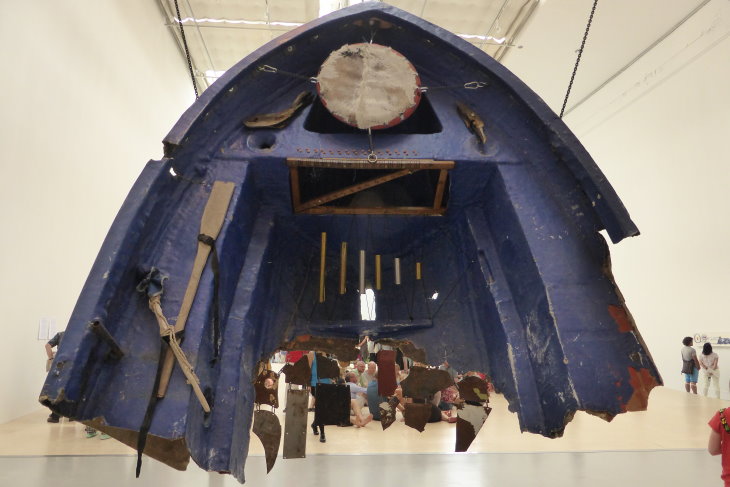
Small and large, the cast-off objects are then transformed into instruments, devices that can sound out into the world. For Galindo, born in 1960 in Mexico City, in these soundings something of the object’s histories and potential futures can be heard. In one sculpture, a glove and a boot suspended from intricate pulleys make an off-kilter “thwack, thwack, thwack” atop a worn rubber-tire drum. In another, the empty shell casings of bullets suspended from a welded metal piñata make a high ring, their brass tops singing out each time that the piñata is struck. These materials—as relics—speak to their past as well as to the imagined lives of the people who once owned them.
In Athens and in Kassel, Galindo is composing new music scores, odes for border crossers. Found materials from both cities will form the basis of new instruments. In Galindo’s hands, a part of a boat might become a string instrument, leftover tubing may now be a flute, a bed from a building in Kassel that provided temporary housing for refugees is potentially a drum.
In Mesoamerica, instruments were understood as talismans for the transit between worlds: “Mesoamerican cultures,” explains Galindo, “believed that our personal objects and the sounds they produce are, in many ways, attached to our journey through this planet.” These new instruments, also talismans, are for another journey: not between worlds but across national lines, and the music they emit brings life to the things left behind. Reliquiae in Latin means “remains,” and these remains are often venerated. Galindo says that, “when designing instruments, my goal is not to obtain the perfect or the most beautiful sound, but to allow the materials to sing in their own voices”—a veneration all its own.
—Candice Hopkins
Posted in Public Exhibition
Excerpted from the documenta 14: Daybook
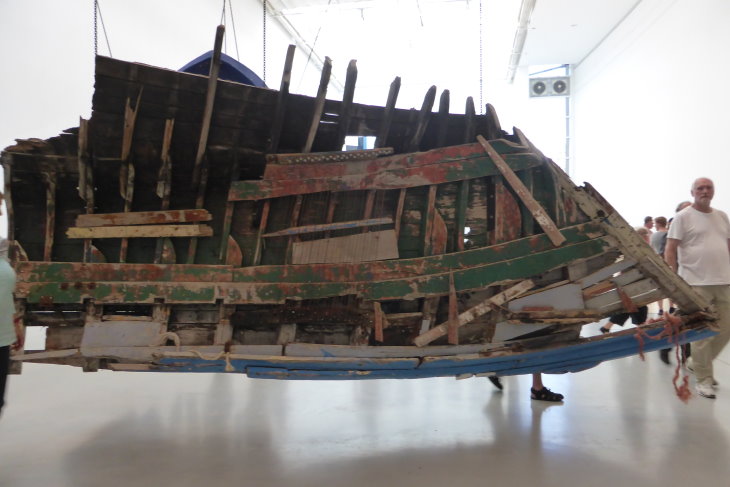
Guillermo Galindo - Fluchtzieleuropahavarieschallkörper (2017)
Remains of fiberglass and wooden boats, lifebelt and paddle from Lesbos (Greece), goatskin, metal tubes, elastic band, scrap metal, harpsichord strings, piano strings, and metal - documenta Halle, Kassel
Gordon Hookey from Australia
with his gigantic wall painting “Murriland!”
TERRAISTS. Gordon Hookey—who was born in Cloncurry, Australia in 1961, belongs to the Waanyi people, and lives in Brisbane—paints words on images. YOU CAN’T HAVE OUR SPIRITUALITY WITHOUT OUR POLITICAL REALITY. Together they enact the reality of Aboriginal peoples in a sociopolitical system that can be traced back to the oppressive and exploitative operations of colonization. He bends and shapes English words, changing their meaning, appropriating a language that is not his own yet the only language he speaks. SORRY! / FUCK SORRY! / SORRY CAN GO GIT’T FUCKED! / GIVE’S THE REALLY, LUBBLY, DEADLY, BIG, SOLID, GOLDEN SORRY / POOR FELLA U.
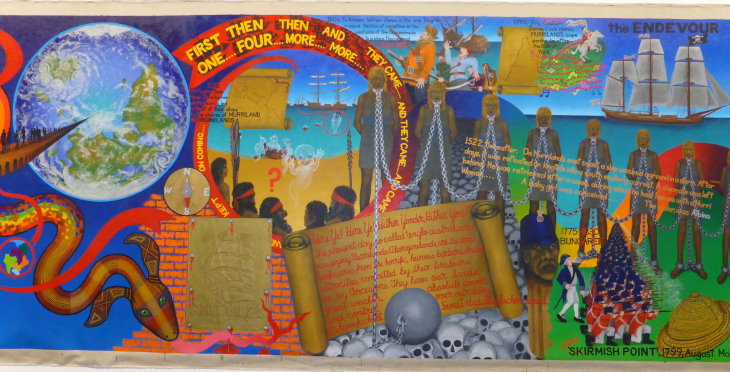
Gordon Hookey - partial view of "MURRILAND!" (2016), Oil on canvas, 2 x 10 m
History comes to us in words—spoken, written, repeated. It can be a scar on our body or a glow of hope in our minds. Hookey paints history as it is being made—in color, form, and stories. His interest in history painting came to fruition through a commission by research platform Frontier Imaginaries, which introduced Hookey to Congolese painter Tshibumba Kanda Matulu (also featured in documenta 14). In the mid-1970s, Tshibumba created a series of 101 paintings that represented the history of his nation, deeply torn by the trauma of colonization and shaped by the forces of militarization and economic neo-imperialism. On encountering Matulu’s work, Hookey considered what a painted history of his homeland, Queensland, would comprise, which resulted in an extensive series of paintings.
The creation history of what is referred to today as Queensland is at the core of the project presented at documenta 14 that spans a series of monumental paintings in Kassel and a public mural in Athens. Hookey juxtaposes the oral traditions transferred across generations of Aboriginal communities with the colonial genesis of Australia—the “exploration” of land, settlement, and erasure of Indigenous cultures, and the implementation of a national narrative to make History with a capital H.
The complexity of Hookey’s project opens up in the reading of these images. The transformation of written, spoken, and lived words into an image that collects the conflicting narratives of national and cultural identity, ultimately collapses history into itself. The multifaceted image that Tshibumba created with his 101 depictions is now captured in the singular image of history. In the same move, the work transposes multinarrative space to linear space, turns fracture into coherence, subversion into validation, and orality into the static record of time. Hookey’s images resonate as strongly as his words, and speak volumes.
—Hendrik Folkerts
Posted in Public Exhibition
Excerpted from the documenta 14: Daybook
